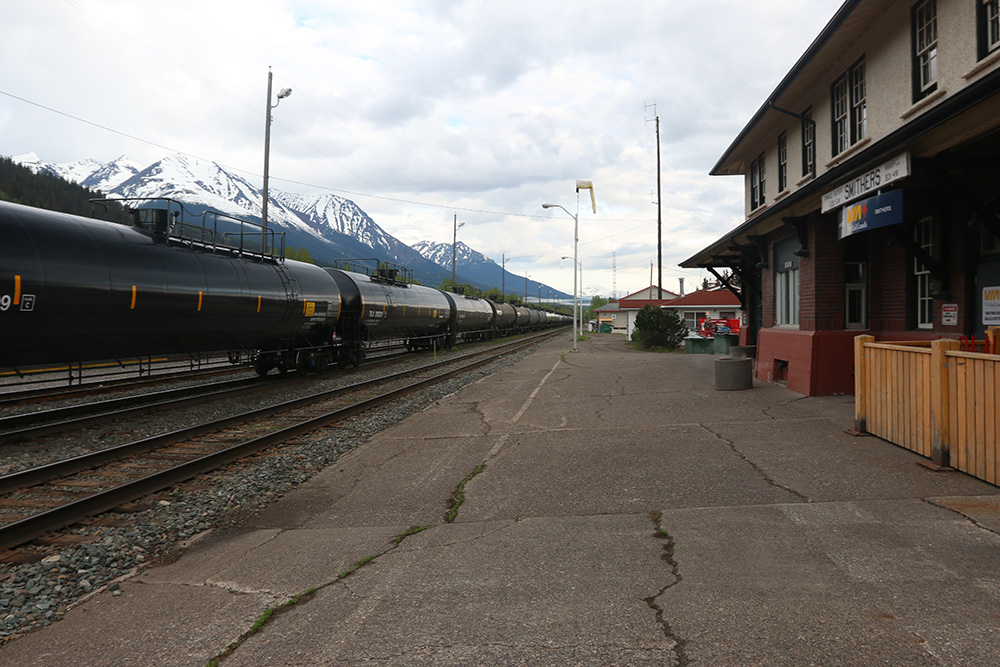As the movement of dangerous goods by rail increases through British Columbia, an independent audit has found that oversight of transportation companies by Transport Canada needs improvement to ensure the safety of railway communities.
Last week, Skeena-Bulkley Valley MP Taylor Bachrach pressed the federal regulator in the House of Commons about the report, which was released late October and showed that Transport Canada had not rectified many shortcomings identified in a similar audit nearly a decade earlier.
Among those are the failure to complete emergency response plans, some of which had languished in draft form for more than a decade, and not following up to ensure companies with violations had come into compliance with safety regulations.
Bachrach isn’t the first to sound the alarm. As rail traffic increases through northern B.C., where ports in Kitimat and Prince Rupert are expanding propane exports, community groups and municipal governments have been demanding increased accountability from the federal government.
The railway between the Alberta border and the coast will become increasingly congested with dangerous goods if three facilities proposed to export propane and other combustibles move ahead.
“There is a large volume of dangerous goods that are transported along [northern B.C.’s] mainline and several projects that would increase the volume of those dangerous goods, which makes the report that we have heard about today such an issue of concern for people in the riding I represent,” Bachrach said.
“Many of the communities along CN’s mainline are protected by volunteer fire departments and their mayors have expressed deep concerns over the years about the transport of dangerous goods and their ability to respond to emergencies.”
Northern B.C. was settled by rail, with the tracks following valley bottoms and hugging banks of rivers like the Skeena and Bulkley. Communities like Smithers, Houston and Burns Lake grew up around the railway, and evacuation zones engulf their downtowns, in many cases overlapping with emergency services like fire departments, hospitals and police stations.
That’s to say nothing of homes and schools that lie within the evacuation boundary.
Yet, in 2011, the Commissioner of the Environment and Sustainable Development, part of the federal auditor general’s office, found that Transport Canada had no national, risk-based compliance inspection plan, failed to consistently follow up to ensure that companies were in compliance and lacked clear roles for monitoring compliance.
It further found that Transport Canada did not grant final approval for nearly half of the emergency response assistance plans in place for regulated companies.
The more recent audit found that while Transport Canada had made some improvements since 2011, there is still much work to be done.
“Transport Canada has more progress to make to address the problems we identified in order to support the safe transportation of dangerous goods,” it states.
“In particular, we found that the department did not always follow up on violations identified through inspections to ensure they had been addressed. In addition, the department had not finished its work to grant final approval of many companies’ plans to respond to emergencies.”
According to the recent 40-page report, in 30 per cent of cases Transport Canada did not follow up with companies to ensure non-compliance had been corrected, in some cases concluding they had despite any evidence. Out of 10 cases requiring a follow-up inspection within 90 days, in four cases no follow up took place, it found.
The report notes that 21 per cent of emergency response assistance plans, those required for companies transporting certain dangerous goods, had only interim approval by November 2019.
Of those, 22 emergency plans — representing about two per cent of the total — had been outstanding for more than 10 years, and one plan had been sitting with only interim approval for more than two decades.
It also notes that the regulator did not have a clear picture of which companies it was regulating.
In response to Bachrach’s questions, Transport Canada deputy minister Michael Keenan said outstanding emergency response assistance plans had decreased over the past decade and were “almost at zero.”
“We’ve made dramatic improvements year after year since the [2011] audit. There are some areas where we have more work to do,” Keenan said. “We don’t have 100-per-cent follow up on inspections, and we’re taking actions now to get us to that 100-per-cent follow up on inspections.”
Over the past decade, Transport Canada’s Transportation of Dangerous Goods Program increased its inspections from 2,000 to more than 5,000, nearly tripled its spending and multiplied staffing by more than 2.5 times, according to the report.
But rail traffic has also increased. According to the report, roughly 50 million metric tonnes of dangerous goods were shipped by rail across Canada last year. Much of that passes through northern B.C. and within two blocks of Anne Hill’s home in Terrace.
Hill, co-chair of the advocacy group North West Watch society, has been lobbying local governments to call for increased safety measures.
Over the past year, Hill has twice presented her concerns to Terrace’s city council. Most recently, she spoke in October about increased risks due to the expansion of propane export facilities in Rupert and Kitimat. She asked council to request a risk assessment from federal Transport Minister Marc Garneau.
The city declined, with one city councillor accusing the group of trying to stall industrial projects. Hill calls the response disappointing, given the concerns about community safety.
“Concerns about the safety of our community should unite us, not divide us,” she says. “I think it’s in everybody’s interest to ask for a risk assessment. The more that it gets suppressed, I think the more it's going to keep popping up.”
The transport of dangerous goods through northern B.C. is expected to increase dramatically in the coming years.
AltaGas/Vopak’s Ridley Island Propane Export Terminal in Prince Rupert, which began operations last year, currently services between 50 and 60 railcars filled with liquefied petroleum gas, or propane, each day. Three other terminals are currently under review.
Pembina’s Prince Rupert terminal, which is under construction and expected to begin operations next year, would add another 50 propane cars each day.
Another terminal in Prince Rupert proposed by Vopak Development Canada would add an additional 240 daily railcars carrying propane, diesel, methanol and other petroleum products.
In Kitimat, Pacific Traverse Energy is a proposed propane export facility that would add another 60 cars per day passing through the region. It is currently undergoing regulatory review.
It’s impossible to know exactly how much of an increase in dangerous goods the new terminals represent, because railway operator CN Rail isn’t required by the federal government to disclose the materials it transports.
Hill says environmental assessments for the projects don’t necessarily look at impacts along the rail lines.
“They only encompass the tank farms themselves,” she says. “There’s no environmental assessment being done of the risk along the rail lines, on the river, through avalanche zones, through towns. There’s no risk assessment being done about those things.”
Communities have reason for concern. Last week, the federal Transportation Safety Board said that track failure was to blame for a freight train derailment between Smithers and Terrace in January.
In March, 28 cars derailed — seven of them carrying propane — east of Prince George, forcing the evacuation of an elementary school 200 metres away.
In May, nine train cars carrying coal derailed near Burns Lake, prompting the village to write a letter to the Transportation Safety Board.
In the letter, Mayor Dolores Funk says the derailment two kilometres outside municipal limits was not reported to the village or the local fire chief. She asks for assurance that the board is monitoring CN Rail’s track maintenance and questions the increase in dangerous goods passing through the region.
“The council has significant concerns that a derailment of hazardous goods is beyond the capacity of our volunteer fire department. What happens if a derailment of dangerous goods occurs within the municipal limits? How and who will deal with this type of disaster?” the letter says.
Funk says CN Rail has never sat down with the community or provided a direct response to council’s concerns.
“Burns Lake, a community like many others on the Highway 16 corridor, is completely interwoven with the rail line. It is unlikely that the early community builders envisioned a time when we would see trains hundreds of cars long, travelling through the heart of communities every eight minutes,” she says, adding that four per cent of goods that travel through her community are considered dangerous.
“It doesn’t take a significant amount of a volatile compound to inflict serious harm. Canada needs to rethink how it allows a company like CN to do business within our borders.”
Burns Lake is not alone in its concern. Dawn Remington is chair of Smithers-based environmental group Friends of Morice-Bulkley. The group has presented to Smithers and Houston councils and to the Regional District of Bulkley-Nechako in recent months, asking it to request a risk assessment from the federal government.
While Smithers, which underwent a recent election, is still considering the request, the regional district and Houston are writing to the federal transportation minister and the Transportation Safety Board, she says.
Remington calls the recent follow-up audit indicating that Transport Canada has not followed up on years of violations “disappointing.”
“If all the proposed propane, diesel and gasoline export terminals are built, the northern B.C. rail line will soon be carrying an unprecedented volume of hazardous cargo. This rail line has never carried this volume of hazardous cargo before and, frankly, CN’s derailment and spill record isn’t great,” she says.
“We’re worried about the towns we live in, and we’re worried about our rivers and salmon. If Transport Canada isn’t regulating this industry, who is looking out for public or environmental safety? We feel like deer in the headlights.”
According to Remington, CN told Smithers council that its nearest emergency hazardous response group is in Prince George, 400 kilometres away. It would take them 12 to 24 hours to arrive in the case of an emergency.
“It seems to me that we need some organized plan for emergency response for all of our towns. Residents need to know what to expect and how to respond in an emergency. We were given no information about the increase in propane going through here,” she says.
When asked for comment, CN senior manager of media relations Jonathan Abecassis said the company takes safety issues seriously by regularly inspecting infrastructure and investing in railway upgrades.
“CN’s Dangerous Goods Team regularly reviews the types and quantities of dangerous goods traffic transported across each province and state and conducts an analysis of the response measures required and resources available to respond everywhere at any time,” he says. “Should any adjustment be required, our teams of experts deploy additional equipment or sign additional agreements to ensure a fulsome response across the network.”
Abecassis adds that CN makes its network emergency response plan available to first responders and encourages use of the AskRail app, a safety tool that provides first responders immediate access to data about what type of materials a railcar is carrying.
The company also offers free training to local first responders, he says. ![]()
Read more: Energy, Rights + Justice, Transportation
















Tyee Commenting Guidelines
Comments that violate guidelines risk being deleted, and violations may result in a temporary or permanent user ban. Maintain the spirit of good conversation to stay in the discussion.
*Please note The Tyee is not a forum for spreading misinformation about COVID-19, denying its existence or minimizing its risk to public health.
Do:
Do not: